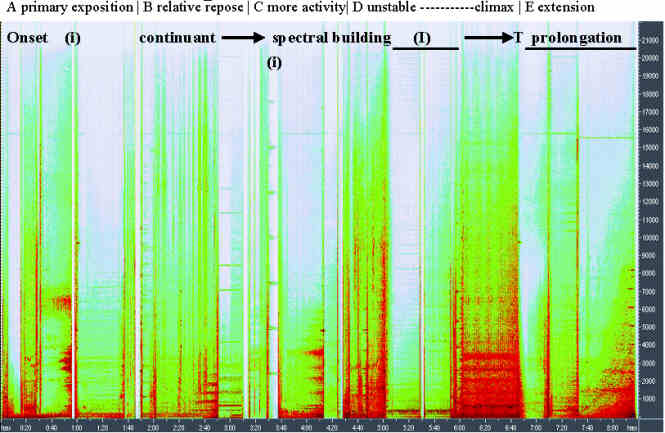Spectro-morphological Structuring Process in Gilles Gobeil’s “Le Vertige Inconnu”
Summary
Introduction | Spectral Overview | Section A | Section B | Section C | Section D | Section E | Summary | Resources
The continuity of this work is based on repeated and varied use of similar material: long increases in spectral energy, repeated iterations of both insect and mechanical origin which are used both texturally and gesturally, sectional interruptions and prolongations, and strong descending attack-decay gestures used to delineate structural sections. Morphological ideas are clearly working at all structural levels: the shape of the sounds, how those sounds are combined to create larger gestures and sections, and the overall structure of the sections through the entire work. The first section acts as a large structural onset, the second as the start of the continuant phase, with sections C and D leading upwards in energy to the climax at the end of section D. Section E works as a prolongation of the terminating gesture used to round off the work. The structural principles of textural continuant transforming into gesture through spectral building with interruptions to heighten the sense of direction, and the use of prolongations to round them out occur simultaneously throughout the structural levels. On the highest level, the relationship between onset, interruption (I), termination (T) and prolongation are summarized below.
Spectral Overview

As stated previously, spectro-morphology describes but one aspect of a composition. Elements such as space and the meaning and contextualization of sounding sources may provide still deeper and richer insights into this work. However, spectro-morphology is the language of sonic experience. Masterworks of western music have traditionally been considered those works demonstrating skillful mastery of their fundamental materials, be they pitch/rhythm motifs or spectro-morphological motifs. Further, the development of these constructive materials into large-scale formal structures reflected on various structural levels is also a hallmark of craftsmanship. Finally, as Smalley emphasizes, the efficacy of a work is dependant on the listener’s experience. Gobeil’s careful attention to detail provides a dramatically linear work whose meaning deepens on subsequent hearings, a crucial trait for success in the fixed world of tape music. Careful study of the structuring principles of such a work provides a useful compositional model, connecting accousmatic music, “the rightful heir to western music”[3], to its roots.
Introduction | Spectral Overview | Section A | Section B | Section C | Section D | Section E | Summary | Resources
Social top